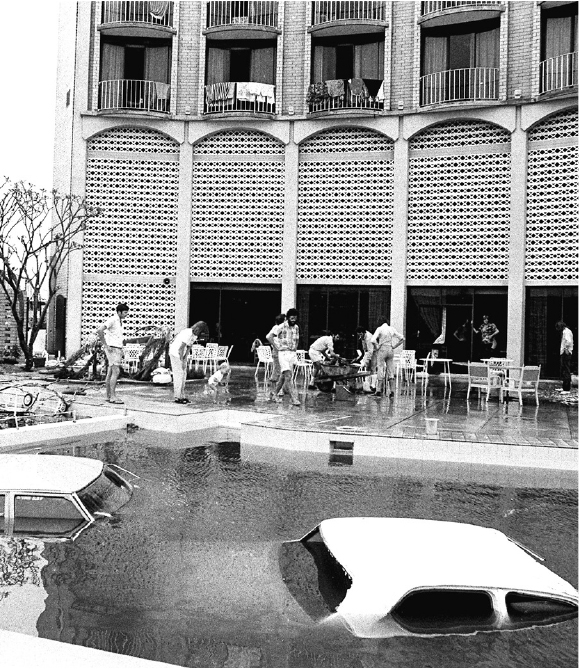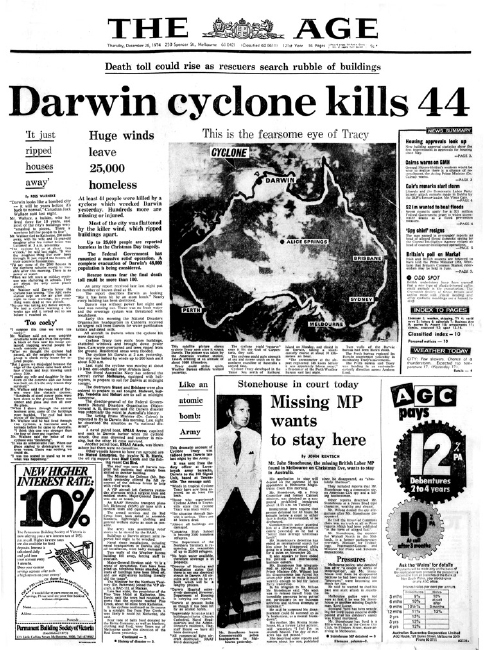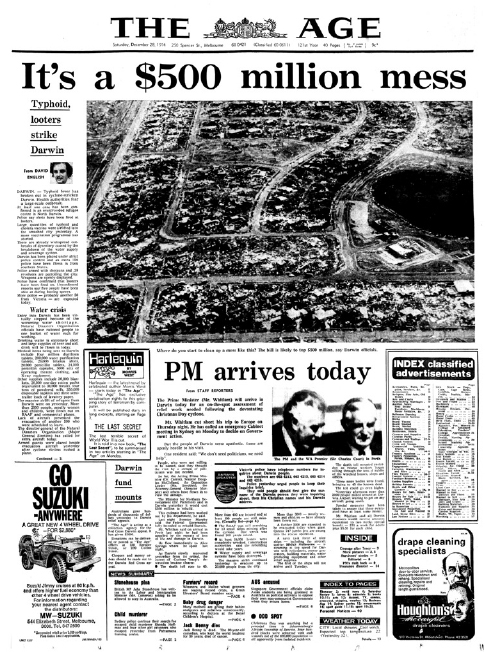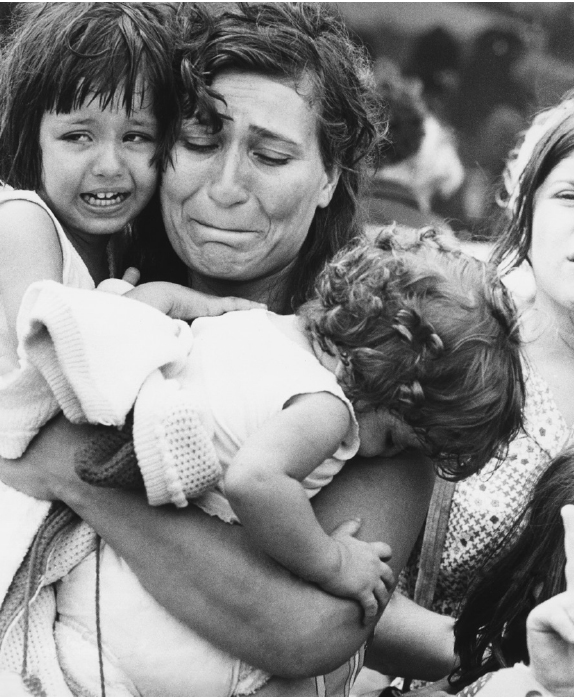Warning (7 page)
Authors: Sophie Cunningham

When Law is sung in Indigenous songs it becomes a way of structuring and interpreting
knowledge as well as communicating it. Boundaries between the past and the present
are fluid and while references will be made to establish a rough time periodââThat
horse and buggy time'
13
âchronology is less relevant than remembering events in a
way that emphasises their meaning. An extension of this is what Deborah Rose has
described as âYear Zero':
14
the moment that something irrevocable shifts in a culture.
For Indigenous people, âYear Zero' is white settlement.
A version of this approach to story seems to have been taken up by survivors to Tracy.
Those interviewed about the cyclone, white and black, talk about pre- and post-Cyclone
Tracy. Neroli Withnall described it to the
7.30 Report
this way: âIt was such a cataclysmic
event that everything was dated according to whether it was “before” or “after”.
It was like BC and AD.' Her now-former husband, John Withnall added, âMy own feeling
is it's as if a line was drawn across our previous life. It's a strange feeling.'
He said, âI felt just a little while back talking to you as if we were almost talking
about some other family, some other place, some other time.'
When we experienceâor learn ofâtraumatic events the brain can capture this moment
as if it's a photograph or a series of photographs. These vivid recollections are
described as âflashbulb memories'. The intensity of these flashes should not be confused
with accuracy, as I learned that day when I found that the image of the cyclone I'd
carried with me for thirty years belonged to the wrong day. It is now accepted that
accuracy diminishes with time, even if the intensity of the feeling does not. So,
for example, three years after 9/11 people tended to be right about the details of
what happened to them, including how they felt, only fifty per cent of the time but
their confidence in that memory remained high.
15
People quoted in this book were interviewed as early as the day itself by journalists
on the ground, or as recently as 2013, by me. The interviews conducted for the Northern
Territory Archivesâoften, but not always, by archivist Francis Goodâwent on from
the early eighties until into the early 2000s. For some, time had made the events
of Christmas Eve 1974 more vivid, for some, less. More crucially though, there was
the slippage caused by the shock of the night itself, and more was caused by what
was to come. Constable G. Townsend: âI was placed in the armory section at the station
and was also the pet destroyerâ¦My hours of duty are not possible to calculate.'
16
Many people, after that first sleepless night, were to go another night, or even
five nights, without sleep. Oral historian Alessandro Portelli has observed that
chronology is more likely to get blurry if events are endured as one continuous occurrence
rather than a series of discrete episodes.
17
Given this, some might question the point of even recounting people's memories of
events, but I'm with oral historian Studs Terkel, who has argued that the impact
of time and memory on personal narratives is not a flaw, but rather one of the things
that make them interesting: âThe Memory manipulates facts and chronology to various
symbolic and psychological ends. This can be as telling as shifting the truth to
better fit in with a person's desired version of events. These gaps help us, in fact,
to identify what is important.' Not all historians find this fluidity of oral history
productive. Patrick O'Farrell wrote in 1979 that oral history was moving into a âworld
of image, selective memory, later overlays and utter subjectivityâ¦And where will
it lead us? Not into history, but into myth.'
18
After Hurricane Sandy in 2012, journalist Steve Fraser wrote that âa mythic memory
of communal suffering, self-sacrifice, and mutual aid' emerges after disaster. âThese
are not fables, but moving accounts drawn from real life. They offer a kind of hope
in disaster and, consoling as they are meant to be, linger on, sometimes forever.
Meanwhile, interred and resting in peace are often the disaster's darker doingsâ¦'
19
And it's true that myths play a large part in the story of Tracy; but, as with all
myths, there is a kernel of truth at their heart. Hedley Beare's version of this
myth is a moving one, and indeed, speaks to real experience.
I understand that when a cyclone or a tragedy occurs, you normally check your immediate
family, the extended family, your neighbours, and you go out into concentric circles.
Since there weren't those extended families in Darwin everybody started checking
on their friends. And one of the reasons why the place rehabilitated the way it did,
in my view, is that it wasâcommunity emerged; people were caring about others. There
were some enormous acts of altruism and kindness that erupted in that week following
the cyclone.
I have no doubt that some of the people quoted here have misremembered what happened
to them. Exaggerated or underestimated their trauma. Embroidered details. I let that
stand. This book is testimony to their understanding of their experiences as well
as to the facts, which were, it is certain, cold and hard.

Cars in the pool of the Darwin Travelodge
RICK STEVENS /
SMH
FAIRFAX

The
Age
's Boxing Day headlinesâ¦
...as they appeared, 26 December 1974
FAIRFAX

â¦as remembered, 28 December 1974
FAIRFAX

Two days after the cyclone, the strain shows on
the face of this woman as she carries
her two
children at Darwin Airport. 27 December 1974
VIC SUMNER /
SMH
FAIRFAX
EXTRAORDINARILY, OUT of a police force of 208, only six failed to arrive at work
on Christmas Day, rostered on or notâdespite injury to themselves and family, the
loss of their homes and, in some cases, their clothes (one bloke turned up in his
speedos). Several were so badly injured they were unable to work and had to be evacuated.
It must be said that there were officers who reported for duty under some duress,
with one officer taking a while to come in after having had to take ârefuge in a
cupboard in the bedroom on the non-approach side, remaining there until the cyclone
ended'.
1
But come midday on Christmas Day there were sixty prisoners in the Fannie
Bay Watch House and only three officers in attendance. Everyone was needed.
Robin Bullock was thirty, but he'd only graduated as a policeman that December. He
can't remember what time he went to work, but it must have been early, and when he
arrived he was put in charge of the morgue that was set up at the Casuarina post
office and left there, unassisted, for some twelve hours. He'd never seen a body
before, but by day's end the count was at thirty-three. Many of them were children.
People came and went, identifying the dead who lay on the floor and tables and benches.
Most of the bodies had suffered extreme compressionâthat is, things had fallen on
them and suffocated or crushed them. Some people had also been severely cut, even
sliced, by corrugated iron. Bullock described his experiences to Francis Good in
2002. âI probably couldn't name them all but I could tell you exactly what they looked
likeâ¦There was one little girl I remember in particular, who was a twin for my daughter.
Her name was Geraldine Brown.' At this point in telling his story Bullock hesitates
for some time and then the tape is turned off. After the tape is turned on again,
Good gives Bullock the chance to talk about something else, but he doesn't take it.
Instead he chooses to elaborate on how he felt. âI thought I was over that,' he said,
âbut I'm not.'
In an interview with the ABC in 1999 Kay Brown remembered how her daughter Geraldine
died.
The roof fell in on top of us and then, of course, we were trapped and they couldn't
find us, obviously. Of course, they [rescuers] were walking on top of us and we're
trying to yell out, âWe're underneath you.' Anyhow, they eventually got us out and
that's when Geraldine died. Geraldine was really frightened and she crawled onto
my back and then the roof caved in and the weight of it and all the debris crushed
her.
Notes in the exercise book that Bullock kept tell us that Geraldine was found by
Constable Stephenson who'd arrived at a house on the corner of Bradford Terrace and
Trower Road, to be told by the girl's father that there was a âgirl underneath the
house dead'.
2
Constable Stephenson himself had spent much of the night lying over
his wife and childâfirst on a bed, and then in the bathâto protect them from falling
debris after his roof had blown off. Once he reported for duty he âspent the morning
freeing trapped persons and conveying deceased persons to the temporary Morgue at
the Casuarina Post Office' then took âcontrol of the Casuarina Shopping Complex with
seven Probationary Constables to secure and issue essential clothing and food'.
He âcontinued this duty until we were relieved by the Commonwealth Police five days
later, I think, as we had lost track of the time and days'. Stephenson only got to
see his family once in the three days before they were evacuated.
Irene Cormick describes the âterrible torment, those men, with those children that
were left behindâ¦In the police station, where they had the bodies of the lassies.
They were identifying children. There was a couple of policemen there, and they workedâoh
I think they didn't come out of that room for five or six days. And they were just
walking like zombies.'
Many of the police who have written or been interviewed about what happened to them,
or what they saw, reveal a real distress and a guiltâshared by non-police personnel
as wellâthat they had survived when others did not. Constable Dane Smith: âIâ¦was
directed to the body of Peter Brian Daffey, 6 yrs. killed when bed under which he
sought refuge collapsed over him. Body taken to Casuarina Post Office. I failed to
identify the body with the result it remained unidentified for several days.'
Bullock again: âAnother terribly sad one I remember was a fellow from the naval baseâhis
wife and two young children. I remember him being there identifying them, and he
was justâGod, the effect it had on him, he was just a shattered manâ¦' Bullock is
referring to Geoffrey William Stephenson of HMAS
Coonawarra
, who arrived at the morgue
to identify his wife, Cherry Leona
3
Rose Stephenson, twenty-two, his three-year-old
stepson, Kenneth James Scott Wheatley, and his six-month-old daughter, Kylie Jane
Stephenson. Stephenson had been stuck on the
Coonawarra
for the duration of the cyclone
and then had been looking in the harbour for bodies. He'd managed to retrieve a few.
As soon as he got to shore he left the boat, and went to his house to look for his
family. At first he was relieved when he didn't find them and assumed they'd got
themselves to safety but after he left the house he had a bad feeling and returned
to it. That was when he lifted the bed and found his family crushed underneath.
Bullock's handwritten notes sit in the archives in a file ârelating to the identification
of deceased persons after Cyclone Tracy'. Reading these notes, looking at the fragile,
spidery handwriting, feels strangely intimate, as if one were witnessing, almost
forty years hence, the most private and vulnerable of moments. In the lie of bodies,
in the clothes worn, the delicate details of life and death reside. Bullock tells
us that Cherry was dressed in a purple cotton sundress, wearing a diamond engagement
ring and wedding ring on her left hand, and a gold friendship ring on her right.
Kenneth was wearing blue shorty pyjamas with a toy pattern. Like his mother, he'd
been asphyxiated. Little Kylie was wearing a white cotton vest, a nappy and blue
plastic pants. Her skull was fractured.
Darwin, originally known as Palmerston, came into existence in 1869. It was established
because British administrators believed a defence outpost was needed against French
and Dutch ships in the region. Its situation was precarious from the beginning, and
previous settlements in the area had been âdefeated by starvation, lack of water,
termites, disease and hostility from the Indigenous locals'. During this period,
military diaries noted âhurricanes'ânot to mention the odd earthquakeâas yet other
trials to be endured. Only the Chinese seemed to be able to get any economic traction
in such a fraught environment, a fact thatâaccording to Tess Lea, the author of the
recent book
Darwin
ââso alarmed the whiskered white men in power down south that the
White Australia Policy was crafted'.
4
The settlement became known as Darwin when the Commonwealth took control of the
Territory in 1911. From the beginning it was a frontier town of outliers, pioneersâof
men. It was a town that people in the rest of Australia, particularly southerners,
didn'tâdon'târeally understand and the place wears its outsider status with pride.
This is one of the reasons that during the writing of this book I found myself having
conversations like the one I had when I headed down the track (aka Stuart Highway)
to the Katherine Writers Festival in 2011.
That night Drags Aloud were performing on an outdoor stage in the market yards. It
was a warm and star-filled night. They did a satirical version of
Wizard of Oz
, a
version that included a drag interpretation of Dorothy uttering the immortal line:
âWe're not in Kansas anymore.' I found myself thinking, the Northern Territory is
a bit like that. Things are different. If you're from down south you're out of your
comfort zone. As we stood around and had a beer, a friend cautioned me that some
Darwin locals (both white and black) might not like me writing about Tracy, they
might feel I was stealing their story. She didn't mean that I had to follow formal
protocols, though that might have been part of it. What she meant was that outsiders
tend to come in, stay a few weeks, do their pieceâand get things wrong. No doubt
I have got some things wrong.
There's something about this proprietorial attitude that makes it hard to know what
really happened up there. Many of the rumours that swept in like so many small tornados
after Tracy spun themselves out. Others, less founded, still flourish today.
One persistent rumour was that there were thousands of bodies under the wreckage
of the northern suburbs and that, as a consequence, mass graves were dug and bodies
dumped in them. Richard Creswick knew of a journalist who'd been in Darwin:
who travelled the Rotary circuit in Victoria for some time dining out on his cyclone
experiences which included helping to personally load two hundred bodies on the back
of truck at Katherineâor to go to Katherineâor something, and that story came back
to us via the ABC in Victoria for us to confirm some months after the event. As I
say, I don't believe it.
Senator Collins described rumours of mass graves as âbullshit' though he understood
why people were sceptical the official death toll was so low. âI mean, it was a small
town in those days and most people knew someone that had died, or knew the family
that had had someone killed.' And post-Tracy Darwin certainly provided plenty of
fuel for fantastic visions and stories of horror. Collins describes oneâ¦
â¦extremely unpleasant scene, with a room with bodies on the floor, and coffins stacked
all over the place, and we were there with this deceased person in a body bag on
a stretcherâ¦In the middle of this, suddenly, up popped a person out of the coffin
that was in the room! And frightened the daylights out of both of us.
It turned out to be a worker grabbing a nap.
You could dismiss talk of a cover-up as paranoid, but conspiracy theory has a rich
history in Darwin, where many also believe that the Australian government was evasive
about the number of people who died during the bombings of 1942. As Tess Lea has
documented in
Darwin
, the media and the government colluded to suggest the attack
was launched from Papua New Guinea and that Japan âdid not have the capacity to wage
an aerial war from sea'. Motivations were in part racistâno one wanted to acknowledge
such a sophisticated approach to warfare from a non-white race, or the failure of
the British to protect them. There was also the related concern that if the full
extent of the attacks was known, people would panic.
5
Prime Minister Curtin was upfront about the fact that many died: he gave the Lowe
Commission a figure of 240 people killed. (This was reported, although there was
also media coverage that downplayed the casualties.) But while the official death
toll ended up sitting on 243, the figure some believe closer to the truth is one
thousand. Certainly more Americans than Australians died during the raids and many
of them lie in unmarked graves at sea. (Tess Lea has drawn a direct line from this
âblood debt' to modern Darwin's increasing role as an American military base.) In
2001 Paul Toohey spoke to Rex Ruwoldt who was stationed in Darwin at the time and
knew people who dug graves for hundreds of bodies. They remembered a figure of three
hundred for one grave and countless others in a second. Another solder interviewed
by Toohey claimed: âAt Mindil Beach, there was over 300 buried in a bomb crater,
who were possibly later moved and reburied in official gravesâ¦In those days, Darwin
had a terrible lot of illegal people.'
6
It's been said that the bodies that washed
to shore were buried in a mass grave around Mindil Beach, before being exhumed and
moved to graves further inland. In 2012 author Roland Perry asserted that âas many
as 1100 people may have died in the bombingâand were buried in mass graves at Mindil
Beach'.
7
Historian Mickey Dewar says stories of the cover-up after the bombings have increased
in credibility over the years, âIf only because old men have little reason to lie.'
8
Military historian Tom Lewis disagrees and attributes an inflated death toll to the
kind of psychological processes that might well have led to the rumours after Tracy
as well: âSeeing death on a widespread scale, with hundreds more wounded, does cause
psychological trauma. Bodies were indeed buried at Mindil Beach and in other places,
records showâand then exhumed later to be taken to places such as Adelaide River
War Cemetery.'
9
No one who had witnessed these burials and retrievals of decomposing
bodies was ever going to forget them and, whatever the truth, we can see the similarities
between these stories and those that sprang up after Tracy. Stories take on a life
of their own. They change shape and move through time, telling and retelling themselves
as needed.
There is a not-so-noble tradition of fudging disaster tolls, too. After San Francisco
was ravaged in the 1906 earthquake the official death toll was 375. Steve Fraser
writes: âFor a savage firestorm coursing through the most densely packed of neighbourhoods,
that low figure surprised people and left some wondering. The answer turned out to
be this: the city fathers were determined to cite a low number so as not to discourage
San Francisco's rebuilding and the outside investments that would require.' The
number of dead in San Francisco was probably ten times higher than the official figure.
Ben Wisner has written about the fate of illegal immigrants working in the twin towers
on 9/11, whose families could neither register their deaths nor claim any assistance.
After Hurricane Katrina the death toll was estimated at 1836 (1464 within New Orleans
itself) but hundreds remained unidentified. The organisation charged with contacting
relatives and identifying bodies ran out of money in 2006. The death rate for those
who had lived through the hurricane continued to rise for some months to come. Anecdotally,
that seems to have been the case after Tracy as well.
